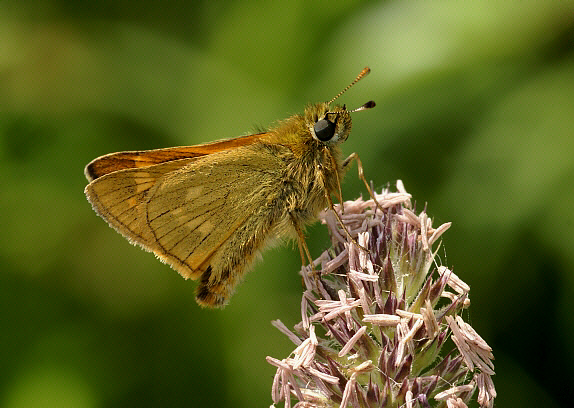 Large Skipper Ochlodes sylvanus, male, Waterperry Wood, Oxfordshire – Adrian Hoskins
Large Skipper Ochlodes sylvanus, male, Waterperry Wood, Oxfordshire – Adrian Hoskins
Introduction
The Large Skipper, in common with most members of the sub-family Hesperiinae, feeds in the larval stage on grasses.
Adult butterflies in this sub-family frequently adopt a characteristic resting posture as shown above, with the forewings held at 45 degrees, and the hindwings held almost flat. Another characteristic is the presence of a dark streak of androconia ( pheromone producing scales ) on the forewings of males, as shown above.
There are a vast number of very similar species found throughout the world. In Britain however the only similar species is the Silver-spotted Skipper, which can easily be told apart by the presence on the latter of prominent silvery spots on the underside hindwings.
This butterfly has previously always been known by the scientific name Ochlodes venatus. However recent research has revealed that venatus only occurs in China. Korea, Siberia and Japan; and that the species occurring in Britain and Europe is actually Ochlodes sylvanus ( also known as faunus ).
 Large Skipper Ochlodes sylvanus female, Fermyn wood, Northamptonshire – Adrian Hoskins
Large Skipper Ochlodes sylvanus female, Fermyn wood, Northamptonshire – Adrian Hoskins
Habitats
Large Skippers can be found commonly throughout England and Wales in almost any grassy habitat but they tend to favour damp but sunny sites such as woodland glades and rides, humid heaths, wild meadows and riversides. Almost all sites are characterised by the presence of bramble bushes and stands of bracken. Open grasslands are also used but populations tend to be much lower.
 Large Skipper Ochlodes sylvanus male, Wiltshire – Adrian Hoskins
Large Skipper Ochlodes sylvanus male, Wiltshire – Adrian Hoskins
Lifecycle
The Large Skipper is single brooded throughout it’s range, normally emerging in mid-late June, and living for about 3 weeks. A small number of individuals emerge later during July and old faded specimens can often be seen in August.
The pale straw coloured dome-shaped egg is laid singly on the underside of grass blades, typically on cock’s foot or false brome. It hatches after about 10 days.
The larvae feed on soft lush grasses, favouring cock’s foot Dactylis glomerata on alkaline or neutral soils, and purple moor grass Molinea caerulea on acid soils. Less frequently used larval foodplants include red fescue Festuca rubra and false brome Brachypodium sylvaticum.
The larva spends the early stages of it’s life within a tube of grass made by joining together 2 grass blades with strands of silk. It periodically emerges from the tube to eject it’s droppings, which are catapulted some distance by flicking them with a comb-like device on it’s tail. It hibernates within a newly constructed tent of grasses and resumes feeding in the spring. When fully grown in early May it rests openly on the upperside of grass blades, but retires to it’s grass tube in poor weather. The mature larva is green and unmarked, with a purplish black head.
The chrysalis is dark brown and shiny, with the long detached proboscis case projecting almost to the tip of the abdomen. It is formed within the larval shelter, head-upwards, and secured by bristles on the head and cremaster. The pupal stage lasts about 2 weeks.
 Large Skipper Ochlodes sylvanus male, Glapthorn, Northamptonshire – Adrian Hoskins
Large Skipper Ochlodes sylvanus male, Glapthorn, Northamptonshire – Adrian Hoskins
Adult behaviour
Large Skippers have a rapid whirring flight, ‘skipping’ from leaf to leaf. They bask with wings held in the characteristic position as illustrated, typically on bramble leaves, bracken, or grass heads.
Males patrol back and forth across their breeding sites in the late morning on warm sunny mornings to search for freshly emerged females. If unsuccessful at this time they switch to a ‘perch and wait’ tactic in the afternoon. Typically a male will then seek a sheltered, sunny spot in a woodland glade, a ride intersection, or at the base of a grassy hillside. There he will sit on a tall grass head or on a leaf of bracken or bramble. He perches with wings either erect or in the characteristic Hesperiine posture, and darts up to intercept every small passing insect.

Large Skipper Ochlodes sylvanus male, Hungerford, Berkshire – Adrian Hoskins
Other males are challenged aggressively and driven off. During these territorial sorties the males buzz frenetically around each other, while flying rapidly in broad circles, soaring to a height of about 4-5 metres above ground level. At this point they separate and the ‘owner’ of the territory returns to it’s original perch – or very nearby, while the intruder moves on to set up a territory elsewhere.
When females are encountered they are chased until they settle, usually on a bush or small tree; and copulation follows after a brief courtship ritual. Copulated pairs can often be found settled on bramble or buckthorn bushes, bracken leaves or coarse grasses in late morning or early afternoon. When copulated both insects keep their wings either closed or held very slightly apart, and are reluctant to fly, but will do so if disturbed.
At grassland sites the butterflies nectar at bird’s foot trefoil, clovers and vetches, but in woodlands they particularly favour bramble blossom and thistles. On heathlands the most common nectar sources are cross-leaved heath and bell heather.

Ochlodes sylvanus territorial male perching on grass head, Ballard Down, Dorset – Adrian Hoskins
